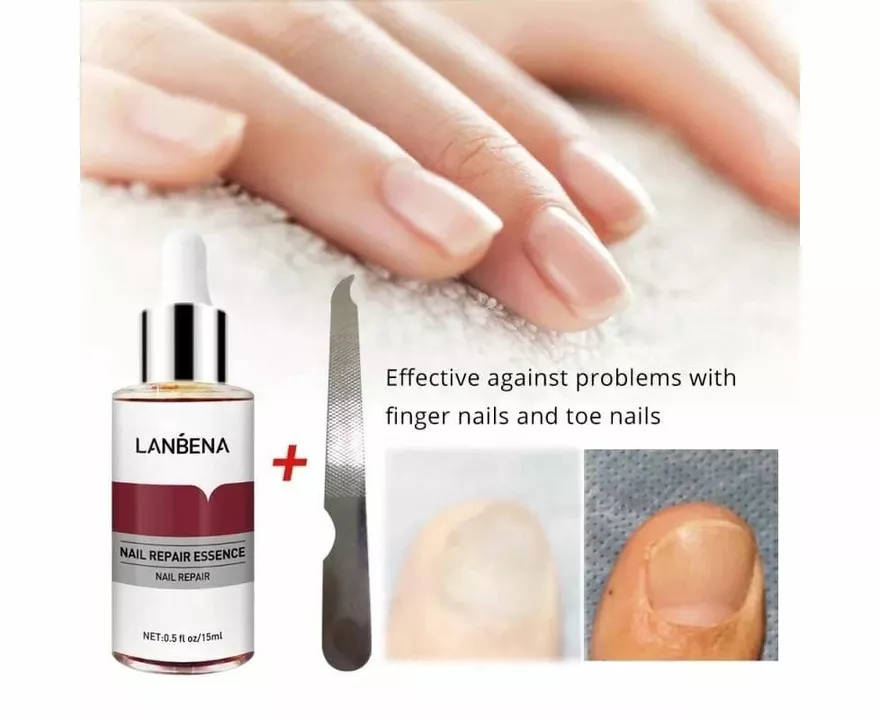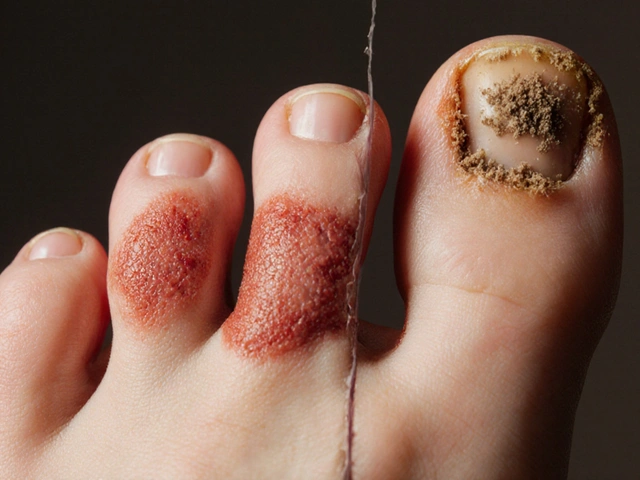Butenafine for Nail Fungus: Is It the Right Treatment for You?

Introduction: Nail Fungus and its Impact on Your Life
Nail fungus, also known as onychomycosis, is a common condition that affects millions of people worldwide. It can be an unsightly and uncomfortable problem, causing embarrassment and self-consciousness. If you're one of the many who suffer from nail fungus, you might be searching for an effective treatment to help you regain your confidence and show off your nails proudly. One such treatment option you might have come across is Butenafine. In this article, we'll explore Butenafine as a treatment for nail fungus and help you determine if it's the right choice for you.
Understanding Nail Fungus: Causes and Symptoms
Nail fungus is caused by various types of fungi, with the most common culprit being a group called dermatophytes. These fungi thrive in warm, moist environments, making your shoes and socks the perfect breeding ground. Other factors that can increase your risk of developing nail fungus include weakened immune systems, poor circulation, and a history of athlete's foot.
Symptoms of nail fungus can vary, but some common signs include yellow or white streaks on the nail, thickening of the nail, brittleness, and a foul smell. If left untreated, the infection can spread to other nails and even the surrounding skin.
Butenafine: What is it and How Does it Work?
Butenafine is an antifungal medication that belongs to the class of drugs known as benzylamines. It works by inhibiting the synthesis of a substance called ergosterol, which is an essential component of fungal cell membranes. This disruption in the production of ergosterol weakens the cell membrane, leading to the death of the fungus and, ultimately, the clearance of the infection.
Butenafine is available in various formulations, including creams, gels, and sprays. For the treatment of nail fungus, it is typically applied as a topical cream directly to the affected area.
Effectiveness of Butenafine in Treating Nail Fungus
Several studies have shown that Butenafine can be effective in treating nail fungus. In one study, participants with onychomycosis applied Butenafine cream to the affected nails daily for 12 weeks. At the end of the treatment period, 71% of participants showed significant improvement in their nail appearance, and 45% experienced complete clearance of the infection.
However, it's important to note that the success rate of Butenafine in treating nail fungus may be lower for infections caused by non-dermatophyte fungi, such as yeasts and molds.
Advantages of Butenafine Over Other Antifungal Treatments
There are several advantages to using Butenafine as a treatment for nail fungus, including:
- Lower risk of side effects: Butenafine is a topical treatment, meaning that it is less likely to cause systemic side effects than oral antifungal medications.
- Convenience: Topical treatments like Butenafine can be applied at home, making them a more convenient option than in-office treatments such as laser therapy.
- Cost-effectiveness: Butenafine is generally more affordable than prescription oral antifungal medications and in-office treatments.
Potential Side Effects of Butenafine
Although Butenafine is generally considered safe and well-tolerated, some people may experience side effects. The most common side effects are mild and include skin irritation, burning, or itching at the site of application. These side effects usually resolve on their own as your body adjusts to the medication.
In rare cases, more severe side effects may occur, such as blistering, swelling, or oozing at the application site. If you experience any of these symptoms, discontinue use of Butenafine and consult your healthcare provider.
How to Use Butenafine for Nail Fungus Treatment
Before applying Butenafine, it's essential to properly clean and dry the affected area. Apply a thin layer of the cream to the nail, surrounding skin, and, if possible, underneath the nail. Be sure to follow the instructions provided by your healthcare provider or on the product packaging for the correct application frequency and duration.
For the best results, it's crucial to be consistent with your treatment and to continue using Butenafine for the full recommended course, even if your symptoms improve before then. This will help ensure that the infection is fully eradicated and reduce the risk of recurrence.
When to Consult a Healthcare Provider
If you're considering using Butenafine for nail fungus treatment, it's important to consult with a healthcare provider to ensure it's the right choice for you. Your healthcare provider can help determine the cause of your nail infection and provide guidance on the most appropriate treatment options. Additionally, if your symptoms worsen or do not improve after several weeks of using Butenafine, it's essential to contact your healthcare provider for further evaluation and possible alternative treatment options.
Conclusion: Is Butenafine the Right Treatment for Your Nail Fungus?
Butenafine can be an effective and convenient option for treating nail fungus, particularly for those with mild to moderate infections caused by dermatophytes. Its advantages over other treatment options include a lower risk of side effects, ease of application, and cost-effectiveness. However, it's crucial to consult with a healthcare provider before starting any new treatment to ensure it's the best option for your specific situation.
With proper use and consistency, Butenafine may help you regain your confidence and enjoy healthy, fungus-free nails once again.




Catherine Zeigler
Hey folks, I just wanted to share a little pep‑talk for anyone battling nail fungus and feeling a bit down about it. First off, you’re not alone; millions of us have dealt with those stubborn stains and thickened nails and came out the other side. The good news is that there are options out there that don’t require you to live in a pharmacy‑filled nightmare, and one of those is Butenafine. When you apply it consistently, you’re giving the fungus a one‑two punch: it blocks the ergosterol pathway and weakens the cell wall, making it easier for your own immune system to finish the job. Stick to the routine, even on those days when you’re tempted to skip because the results seem slow, because persistence is the secret sauce that turns a 71 % improvement into a 45 % cure. Remember that nail growth is a slow process, so it can take a few months before you actually see the full transformation, but every little change is a win. Think of each week of diligent application as a step toward getting your confidence back, especially when you’re showing off shoes that you used to hide. If you notice a little itching or mild irritation, that’s just the skin adjusting – keep the area clean and your doctor will reassure you if it ever gets out of hand. And hey, don’t forget to pair the treatment with good hygiene habits: keep your feet dry, rotate your shoes, and give those socks a break. All of those small lifestyle tweaks amplify the effectiveness of the cream and lower the chance of a rebound infection. In short, if you’ve got a mild to moderate case and you’re looking for a topical that’s affordable and easy to use, give Butenafine a solid try. Just stay consistent, stay patient, and celebrate the tiny victories along the way – you’ve got this! Your nails will gradually regain their natural color and strength, and you’ll notice the stubborn yellow fades away. Over time, you’ll also feel less self‑conscious about taking off shoes in public or wearing sandals. The confidence boost that comes with healthier nails can spill over into other areas of your life, making you feel more put‑together overall. If you’re ever unsure, a quick check‑in with a dermatologist can give you tailored advice without breaking the bank. So keep the faith, keep the cream on, and let your nails do the talking.
henry leathem
Listen up, the article glosses over the pharmacodynamic limitations of Butenafine when applied to the nail plate. Topical delivery suffers from suboptimal keratin penetration, so the MIC values achieved are often below therapeutic thresholds for non‑dermatophyte pathogens. Moreover, the cited 71 % improvement lacks a rigorous intention‑to‑treat analysis, making the efficacy claim dubious at best. If you’re relying on a cream without adjunctive mechanical debridement, you’re essentially gambling on a modest fungistatic effect. Bottom line: don’t be fooled by the hype; consult a specialist who can offer systemic agents with proven nail matrix absorption.
jeff lamore
While I see your point about the pharmacokinetic challenges, it’s also true that many patients prefer a non‑systemic option when the infection isn’t severe. The study referenced does have limitations, yet it still provides a useful real‑world snapshot for mild cases. It’s advisable to weigh the convenience and lower side‑effect profile against the potentially slower clearance rate. In practice, a combined approach-topical use plus proper foot hygiene-often yields satisfactory results without the need for systemic drugs. Ultimately, a shared decision with a healthcare provider remains the safest route.
Kris cree9
Totl nonsense, this creams never work lol
Paula Hines
We must contemplate the collective responsibility of a nation to safeguard the health of its citizens in every corner, including the seemingly trivial realm of nail health. A robust healthcare system should provide affordable access to treatments such as topical antifungals without imposing bureaucratic hurdles. When individuals neglect basic foot care they inadvertently burden the community with preventable infections. The culture of neglect can be traced to a broader disregard for personal discipline that weakens the social fabric. By embracing diligent hygiene practices we reinforce the moral fortitude that defines a strong nation. The efficacy of a medication like Butenafine is amplified when the user commits to consistency and does not abandon the regimen at the first sign of irritation. A short episode of mild burning should be viewed as a minor inconvenience rather than a reason to surrender. Patience in the therapeutic process mirrors the patience required to build a resilient society. The incremental improvements observed over weeks are proof that incremental effort yields cumulative gains. An informed citizen will weigh the cost‑benefit of a low‑priced cream against the high cost of systemic side effects. This rational calculus reflects the enlightened mindset of a populace that values both liberty and wellbeing. Avoiding reckless self‑medication without professional counsel protects both the individual and the collective. The synergy between personal responsibility and accessible healthcare is the cornerstone of national prosperity. Therefore the decision to use Butenafine should be guided by both empirical evidence and a patriotic commitment to health. In the end the true victory lies not merely in clearer nails but in a society that upholds the virtues of diligence and preventive care.